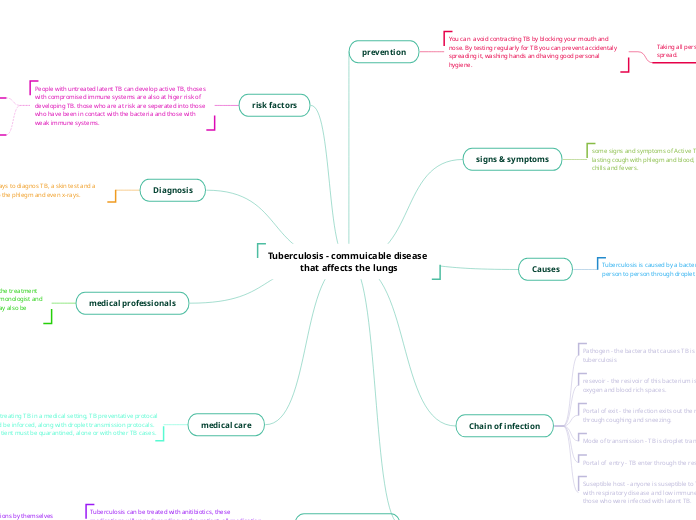Tuberculosis - commuicable disease that affects the lungs
prevention
You can avoid contracting TB by blocking your mouth and nose. By testing regularly for TB you can prevent accidentaly spreading it, washing hands an dhaving good personal hygiene.
Taking all perscribed medications properly will also stop the spread.
signs & symptoms
some signs and symptoms of Active Tuberculosis are; long lasting cough with phlegm and blood, weightloss, chest pain, chills and fevers.
Latent TB happens when someone with TB shows no symptoms and cannot infect anyone else.
TB has the ability to spread to other areas of the body.
Causes
Tuberculosis is caused by a bacteria, and is spread from person to person through droplet transmission.
droplet transmission is when viruses or bacteria travel though the air via sneezes, coughs or speaking.
Chain of infection
Pathogen - the bactera that causes TB is called mycobacterium tuberculosis
resevoir - the resivoir of this bacterium is in the body , in oxygen and blood rich spaces.
Portal of exit - the infection exits out the repespiratory system through coughing and sneezing.
Mode of transmission - TB is droplet transmission
Portal of entry - TB enter through the respiratory system
Suseptible host - anyone is suseptible to TB, especially those with respiratory disease and low immune systems, aswell as those who were infected with latent TB.
risk factors
People with untreated latent TB can develop active TB, thoses with compromised immune systems are also at higer risk of developing TB. those who are at risk are seperated into those who have been in contact with the bacteria and those with weak immune systems.
those with organ transplants, who suffer from addiction and certain types of cancer, Very old or very young people.
so people that have been in contatct with a TB positive patient, immigrants from TB high areas and people that work at high TB risk areas - hospitals or nursing homes.
Diagnosis
There are two major ways to diagnos TB, a skin test and a blood test. there is also the phlegm and even x-rays.
The skin test is where they inject non-infectious TB protien under the skin and determine the result from the reaction, this take about 2 - 3 days.
medical professionals
some medical professional that participate in the treatment and recover of TB are Your family doctor, a pulmonologist and an internist. an infectious disease specialist may also be refered.
your family doctor will refer you to the pulmonologist, who specializes in diseases of the respiratory system and the internest, who specializes in the treatmeant of internal organs.
medical care
when treating TB in a medical setting, TB preventative protocal should be inforced, along with droplet transmission protocals. the patient must be quarantined, alone or with other TB cases.
everything going in and out of the room must be sanitized properly, especially the air - using a high efficency air filter or uv irradiation.
treatmeant options
Tuberculosis can be treated with anitibiotics, these medications will vary depending on the patient. all medication must be taken according to proper instructions for the entierty of the perscribed time.
people that are unable to take the madications by themselves are able to apply for observed care, where a nurse will help them take medication at the proper times
medication will also be provided fro symptom management, the chest pain and the cough.
